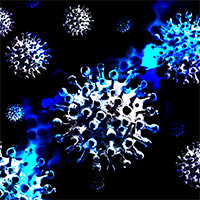Cardiopulmonary exercise pattern in patients with persistent dyspnoea after recovery from COVID-19
Keywords:
CPET, COVID-19, postdischarge dyspnoea, post-COVID-19 syndromeAbstract
Cause and mechanisms of persistent dyspnoea after recovery from COVID-19 are not well described. The objective is to describe causal factors for persistent dyspnoea in patients after COVID-19. We examined patients reporting dyspnoea after recovery from COVID-19 by cardiopulmonary exercise testing. After exclusion of patients with pre-existing lung diseases, ten patients (mean age 50±13.1 years) were retrospectively analysed between May 14th and September 15th, 2020. On chest computed tomography, five patients showed residual ground glass opacities, and one patient showed streaky residua. A slight reduction of the mean diffusion capacity of the lung for carbon monoxide was noted in the cohort. Mean peak oxygen uptake was reduced with 1512±232 ml/min (72.7% predicted), while mean peakwork rate was preserved with 131±29 W (92.4% predicted). Mean alveolar-arterial oxygen gradient (AaDO2) at peak exercise was 25.6±11.8 mmHg. Mean value of lactate post exercise was 5.6±1.8 mmol/l. A gap between peak work rate in (92.4% predicted) to peak oxygen uptake (72.3% pred.) was detected in our study cohort. Mean value of lactate post exercise was high in our study population and even higher (n.s.) compared to the subgroup of patients with reduced peak oxygen uptake and other obvious reason for limitation. Both observations support the hypothesis of anaerobic metabolism. The main reason for dyspnoea may therefore be muscular.
References
WHO. Coronavirus Disease (COVID-19) Dashboard 2020 [updated 09.09.2020]. Available from: https://covid19.who.int/
Guan WJ, Ni ZY, Hu Y, Liang WH, Ou CQ, He JX, et al. Clinical characteristics of coronavirus disease 2019 in China. N Engl J Med 2020;382:1708-20.
Li Q, Guan X, Wu P, Wang X, Zhou L, Tong Y, et al. Early transmission dynamics in Wuhan, China, of novel coronavirus-infected pneumonia. N Engl J Med 2020;382:1199-207.
Wölfel R, Corman VM, Guggemos W, Seilmaier M, Zange S, Müller MA, et al. Virological assessment of hospitalized patients with COVID-2019. Nature 2020;581:465-9.
Kaye R, Chang CWD, Kazahaya K, Brereton J, Denneny JC, 3rd. COVID-19 anosmia reporting tool: Initial findings. Otolaryngology--head and neck surgery : official journal of American Academy of Otolaryngol Head Neck Surg 2020;163:132-4.
Huang C, Wang Y, Li X, Ren L, Zhao J, Hu Y, et al. Clinical features of patients infected with 2019 novel coronavirus in Wuhan, China. Lancet 2020;395:497-506.
Halpin SJ, McIvor C, Whyatt G, Adams A, Harvey O, McLean L, et al. Postdischarge symptoms and rehabilitation needs in survivors of COVID-19 infection: A cross-sectional evaluation. J Med Virol 2020;93:1013-22.
Carfì A, Bernabei R, Landi F. Persistent symptoms in patients after acute COVID-19. JAMA 2020;324:603-5.
Wang X, Xu H, Jiang H, Wang L, Lu C, Wei X, et al. The clinical features and outcomes of discharged coronavirus disease 2019 patients: A prospective cohort study. QJM 2020;113:657-65.
Garrigues E, Janvier P, Kherabi Y, Bot AL, Hamon A, Gouze H, et al. Post-discharge persistent symptoms and health-related quality of life after hospitalization for COVID-19. J Infect 2020;81:e4-6.
Dunmire SK, Verghese PS, Balfour HH, Jr. Primary Epstein-Barr virus infection. J Clin Virol 2018;102:84-92.
Balfour HH Jr, Dunmire SK, Hogquist KA. Infectious mononucleosis. Clin Transl Immunology 2015;4:e33.
Brandstetter S, Dodoo-Schittko F, Brandl M, Blecha S, Bein T, Apfelbacher C. Ambulatory and stationary healthcare use in survivors of ARDS during the first year after discharge from ICU: findings from the DACAPO cohort. Ann Intensive Care 2019;9:70.
Orsucci D, Ienco EC, Nocita G, Napolitano A, Vista M. Neurological features of COVID-19 and their treatment: a review. Drugs Contex 2020;9:2020-5-1.

Published
Issue
Section
License
Mattioli 1885 has chosen to apply the Creative Commons Attribution NonCommercial 4.0 International License (CC BY-NC 4.0) to all manuscripts to be published.




